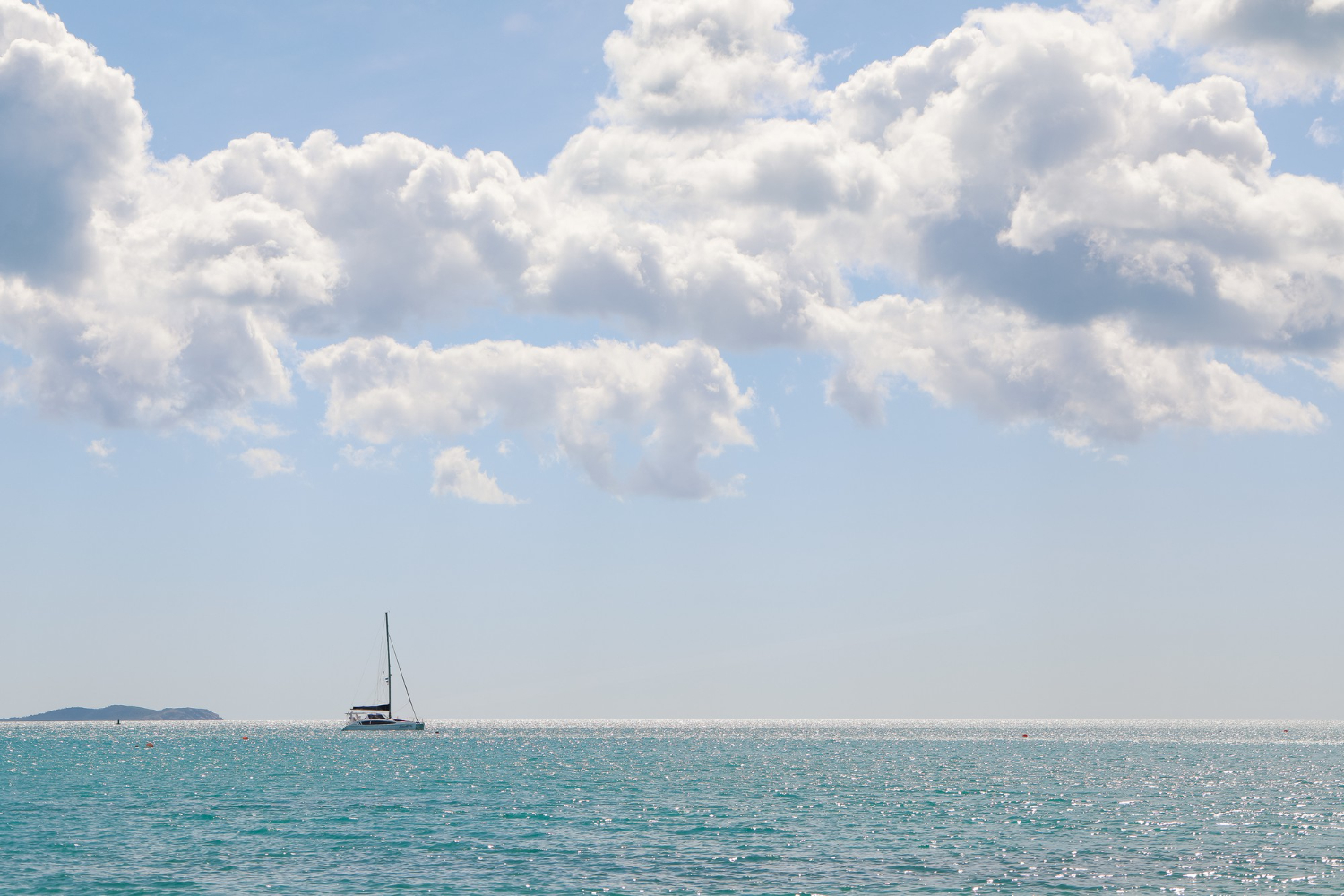바다를 항해할 때 구름을 이해하는 것은 조타 방법을 아는 것만큼이나 중요한 기술이 됩니다. 구름의 종류, 수준, 형성을 인식하면 변화하는 날씨 패턴을 예측하는 데 중요한 우위를 점할 수 있습니다. 연습을 통해 레이더 핑이나 기압이 떨어지기 훨씬 전에 문제를 감지하는 방법을 배울 수 있습니다.
이 글에서는 모든 보트 여행자가 알아야 할 구름과 하늘, 그리고 그 신호가 안전한 보트를 타는 데 어떤 의미가 있는지 자세히 살펴봅니다.
보트를 위한 클라우드 이해하기: 클라우드가 중요한 이유
고대 선원들이 현대적 도구 없이 어떻게 항해했는지 궁금한 적이 있다면 하늘에 답이 있습니다. 그들은 구름의 패턴과 날씨 신호를 읽는 능력을 연마했습니다. 오늘날에도 구름을 이해하는 것은 특히 일기 예보가 모호하거나 지연될 때 항해에 있어 매우 중요한 역할을 합니다.
날씨 변화로 인한 보트 사고의 원인이 되는 경우가 많은 만큼, 구름을 효과적으로 해석하면 더 안전한 결정을 내리고 방심하는 위험을 피하는 데 도움이 됩니다.
클라우드 기본 사항: 클라우드의 수준과 그 의미
구름은 일반적으로 고기압, 중층, 저층 구름으로 분류됩니다. 각 유형은 현재 및 미래의 기상 조건에 대한 단서를 제공합니다.
높은 수준의 클라우드: 변화의 첫 신호
권운과 같은 고층 구름은 20,000피트 상공에서 얇고 줄무늬가 있는 형태로 나타납니다. 얼음 결정으로 이루어진 이 구름은 전선보다 하루나 이틀 먼저 도착하는 경우가 많습니다. 이러한 구름이 늘어나는 것을 발견했다면, 특히 하늘에 고전적인 고등어 하늘 패턴이 있다면 미리 생각해야 할 때입니다.
중간 레벨 구름: 중간 메신저
알토스트라투스 그리고 알토쿠뮬러스 구름은 6,500~20,000피트 상공에서 형성되며 짙고 회색으로 보일 수 있습니다. 일반적으로 따뜻한 전선이 유입되고 수분이 상승하는 것과 관련이 있습니다. 언제 중간 수준의 구름 에 퍼져 있습니다. sky에서 불과 몇 시간 거리에 있는 rain 또는 악화 날씨.
저층 구름: 보트를 타는 사람에게 가장 좋은 지표
저층 구름은 6,500피트 이하에서 형성되기 때문에 해상 관측에 가장 유용합니다. 짙은 성층운이 어두워지고 낮아지면 폭풍이 다가오고 있음을 의미할 수 있습니다. 뭉게구름은 종종 날씨가 맑다는 신호이지만, 수직으로 성장하여 뇌운으로 변하면 심각하게 받아들여야 합니다.
하늘 읽기: 모든 보더가 알아야 할 구름 패턴
보트를 타기 위해 구름을 이해한다는 것은 시각적 단서를 빠르게 해석할 수 있어야 한다는 뜻입니다. 다음은 주의해야 할 몇 가지 주요 징후입니다:
고등어 하늘과 날씨 변화
고등어 하늘은 단순히 예쁜 것 이상의 경고입니다. 비늘처럼 보이는 이 구름은 높은 고도에 습기가 있다는 신호이며, 종종 폭풍우가 발생하기 전에 나타납니다. 변화하는 바람과 함께 이 구름이 보인다면 곧 변화가 있을 수 있습니다.
아침이나 밤의 붉은 하늘?
운율은 여전히 유효합니다:
- "밤의 붉은 하늘선원의 기쁨입니다."
- "붉은 하늘 아침입니다, 선원들이 경고를 받다."
저녁에 붉은 하늘은 서쪽의 맑은 하늘을 의미하며, 날씨가 맑아지고 있음을 나타냅니다. 반대로 새벽에 하늘이 붉으면 저기압이 형성되어 비가 빠르게 다가오고 있음을 의미할 수 있습니다.
적운과 모루 모양
적란운은 일반적으로 안전하지만, 구름이 우뚝 솟거나 모루를 형성하기 시작하면 잠재적인 폭풍우 운반자인 적란운으로 발전합니다. 아직 천둥소리는 들리지 않을 수도 있지만, 적란운은 번개, 폭우, 거친 날씨를 빠르게 가져올 수 있습니다.
보트 안전을 위한 클라우드 이해
왜 여기서 핵심 문구를 다시 살펴볼까요? 보트를 타기 위해 구름을 이해한다는 것은 능동적으로 대처한다는 것을 의미하기 때문입니다. 현재 상태를 인식하는 것뿐만 아니라 한 시간 후에 어떤 일이 일어날지 예측하는 것이 중요합니다. 이러한 예측 기술은 해양 날씨가 급변하는 지역에서 특히 중요합니다.
다음 사항을 주의 깊게 살펴보세요:
- 스트라이킹 권운 구름
- 농축 레벨 클라우드
- 천장 낮추기
- 클라우드의 갑작스러운 이동 sky
디바이스에 알림이 표시되기 훨씬 전에 귀중한 인사이트를 얻을 수 있습니다.
구름은 날씨 변화에 선행합니다: 알아야 할 사항
클라우드가 변화에 선행하는 방식을 이해하면 의사 결정에 도움이 됩니다. 예를 들어
- 낮은 수준의 구름 점점 더 짙어지나요? 다음 사항에 대비하세요. rain.
- 중간 수준의 구름 서쪽에서 이동 중인가요? 온난 전선이 다가오고 있을 가능성이 높습니다.
- 높은 수준의 클라우드 점점 커지고 있나요? 24시간 이내에 더 큰 시스템이 움직일 수 있습니다.
시각적 징후와 풍향 및 기압 변화와 같은 도구를 결합하면 날씨 예측이 더욱 정확해집니다.
도구는 도움이 되지만 감각을 대체할 수는 없습니다.
해상 무전기, GPS, 앱은 훌륭하지만 눈으로 직접 보는 것을 대체할 수는 없습니다. 특히 물 위에서는 실시간 인식이 중요합니다. 구름을 관찰하고, 구름이 얼마나 빨리 변하는지 주목하고, 바람의 변화를 염두에 두는 것이 예보에 수동적으로 의존하는 것보다 훨씬 더 도움이 될 것입니다.
언제 걱정해야 하는지 알고 싶으신가요? 구름을 보세요. 구름은 다른 어떤 것보다 먼저 신호를 보내는 경우가 많습니다.
보트 여행 계획을 위한 클라우드 이해
외출하기 전에 sky:
- Are 레벨 클라우드 빠르게 움직이시나요?
- 혹시 고등어 하늘?
- 일출로 인해 붉은 하늘?
이러한 지표는 어떤 단일 예보보다 상황을 더 잘 파악하는 데 도움이 됩니다. 시간이 지남에 따라 클라우드에 대한 이해가 깊어지면 더욱 유능하고 자신감 있는 전문가로 거듭날 수 있습니다. boater.
안전한 항해에서 구름의 역할
보트를 타는 습관에 구름을 이해하는 습관을 들이는 것은 안전을 강화하는 가장 간단한 방법 중 하나입니다. 잠시만 주위를 살피는 것만으로도 보트와 여행, 나아가 생명을 구할 수 있습니다.
기억하세요:
- 낮은 수준의 구름 = 빠른 변화를 주시합니다.
- 중간 수준의 구름 = 수분 증가
- 높은 수준의 클라우드 = 초기 날씨 알림
- 붉은 하늘, 고등어 하늘및 구름 모양 = 현명하게 읽기
꾸준한 연습을 통해, 단순히 보는 것에서 그치지 않고 sky 가 알려주고 있습니다.
최종 생각: 하늘은 안전망입니다
하늘을 읽는 능력을 키우면 망망대해에서도 주변 환경을 통제할 수 있습니다. 이 기술을 데이터, 현지 지식, 주의력과 결합하면 물 위에서 가장 잘 준비된 사람이 될 수 있습니다.
보트를 타기 위해 구름을 이해하는 것은 시대를 초월한 기술이며 매우 현대적인 이점이 있습니다. 눈을 믿고, 표지판을 믿고, 더 스마트하게 보트를 타세요.

 보트를 타기 위한 구름의 이해: 안전한 물놀이를 위한 가이드">
보트를 타기 위한 구름의 이해: 안전한 물놀이를 위한 가이드">
